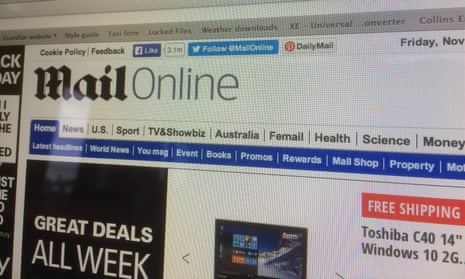The Daily Mail belongs to a proper public company that gives regular briefings to its shareholders. So quarter by quarter and year by year you can see pretty transparently what’s going on – especially in the misty area where print publishing declines as digital reach bounds forward. But there aren’t many bounds in the Mail’s results for the year end to September. On the contrary…
We were told to expect £80m in digital revenues. In fact only £73m transpired. Hopes of £100m next year duly expire. Some 41% growth last year has slowed to 18% – and, though that sounds good by most standards, it is also signals a grinding halt to vaulting expectation. Mail print and circulation revenues fell away (down 12% for print ads in the last six months). Digital growth couldn’t cover that. The coming year, says the group chief executive, “largely depends on the print advertising environment balanced against further growth in digital areas”. Life on a seesaw.
What these figures reflect, moreover, is a general malaise – not some particular failure of Mail operation. The newspaper’s website, by some standards, is the biggest such site in the world, with 13.2 million unique browsers every day. Ambition to conquer America is manifest. In nine years, the Mail team – led by Martin Clarke – has zoomed from zero to heroic web status. It’s a real achievement, but not yet a success with profits to match. And all daily paper sites – plus many beyond – are feeling the same pinch.
Print ad revenues caught a deep chill early in 2015. Digital revenues have sickened, too – though for different reasons. Print takes all the legacy pain and jeers, of course. But digital’s forward march has been halted by the curse of ad blocking: 18% of UK adults, on the latest surveys, now block away – up 3% since June.
Moreover, the separate surge of news views via mobile isn’t quite the wonder that was hoped. Papers from the Independent (171% boosted by smartphone and tablet) to the Mirror (121% on the latest National Readership Survey) are cleaning up on mobile – but finding that it isn’t advertising heaven.
Welcome to a classic bind. Readership figures may grow astronomically, but someone has demolished the seesaw. Transition from print to online sits somewhere betwixt and between. That’s a blow for the Mail, though transition has never been really its game. (No one thinks of the Clarke Mail Online as the eventual successor to the Daily Dacre). It’s even more of a problem for papers that foresee some gradual replacement of all print endeavours by digital versions. Where does the money come from?
Meanwhile, what to do about the ad-blocking crisis? Some shrug and just hope it will go away. Some threaten to block site access as quid pro quo. Some become introspective and strive to do better.
“We think we’re beginning to skate on thin ice in terms of the relationships we have with advertisers and audiences,” Tim Gentry, the Guardian’s global revenue director, told an industry meeting recently. “Five to six years on, we have to look at ourselves with a bit of a harsh yardstick and say we’ve not really delivered on that promise.”
It is a very uncertain world out there now: and that uncertainty needs registering by everyone who reads the press and cares about its future, a world of booming readership and furrowed brows. “In the end, everybody has to do what works,” said the editor of the Times the other day. But first they have to find out what does, indeed, work.

